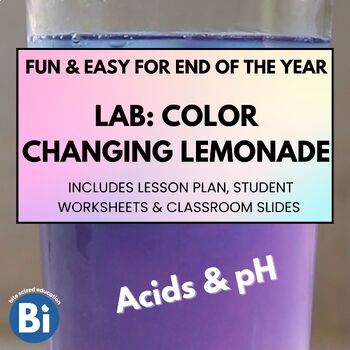Color Changing Lemonade Lab (Fun & Easy End of Year Science Activities) (6-8)
Grade Levels
6th - 9th
Subjects
Resource Type
Standards
NGSSMS-PS1-3
NGSSMS-PS1-1
Formats Included
- Google Drive™ folder

Made for Google Drive™
This resource can be used by students on Google Drive or Google Classroom. To access this resource, you’ll need to allow TPT to add it to your Google Drive. See our FAQ and Privacy Policy for more information.
Description
This lesson centers around a lab where students make their own lemonade from fresh lemons and a special tea that changes color due to changes in pH. It's a fun and easy lab that can be used to talk about acids and pH is a highly visual and tasty way.
This Lesson Includes all of these materials:
- Lab: Color Changing Lemonade
- Instructional How-To Lab Video + "Science Behind" Video
- Classroom Slides with discussion prompts, lesson flow, and embedded videos
All materials are included in a Google Drive folder
Total Pages
Answer Key
N/A
Teaching Duration
1 hour
Report this resource to TPT
Reported resources will be reviewed by our team. Report this resource to let us know if this resource violates TPT’s content guidelines.
Standards
to see state-specific standards (only available in the US).
NGSSMS-PS1-3
Gather and make sense of information to describe that synthetic materials come from natural resources and impact society. Emphasis is on natural resources that undergo a chemical process to form the synthetic material. Examples of new materials could include new medicine, foods, and alternative fuels. Assessment is limited to qualitative information.
NGSSMS-PS1-1
Develop models to describe the atomic composition of simple molecules and extended structures. Emphasis is on developing models of molecules that vary in complexity. Examples of simple molecules could include ammonia and methanol. Examples of extended structures could include sodium chloride or diamonds. Examples of molecular-level models could include drawings, 3D ball and stick structures, or computer representations showing different molecules with different types of atoms. Assessment does not include valence electrons and bonding energy, discussing the ionic nature of subunits of complex structures, or a complete depiction of all individual atoms in a complex molecule or extended structure.


